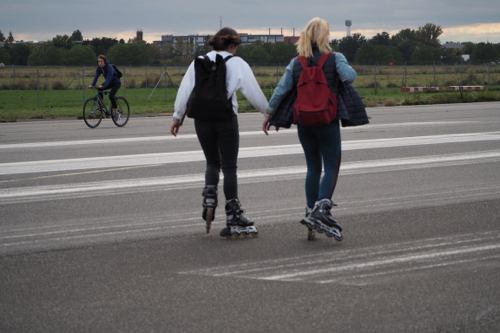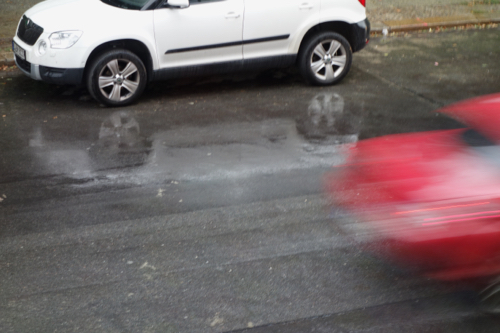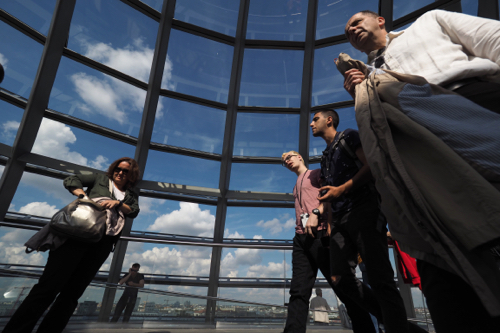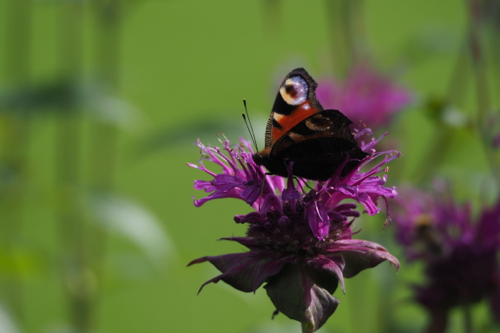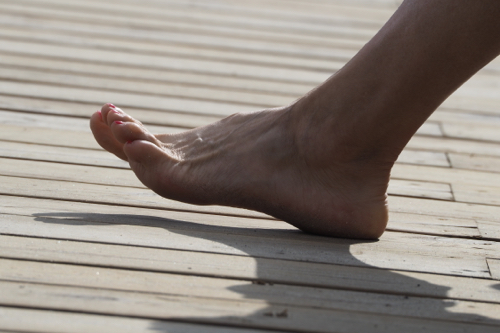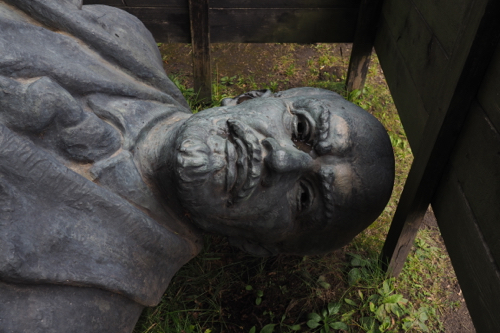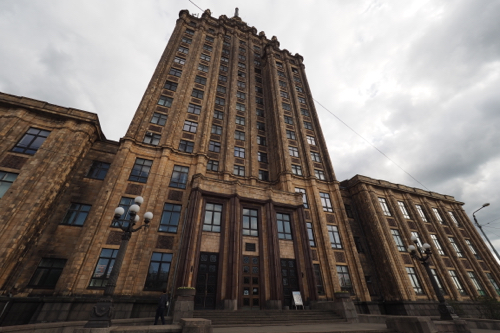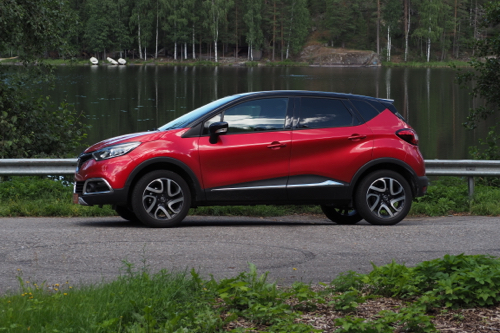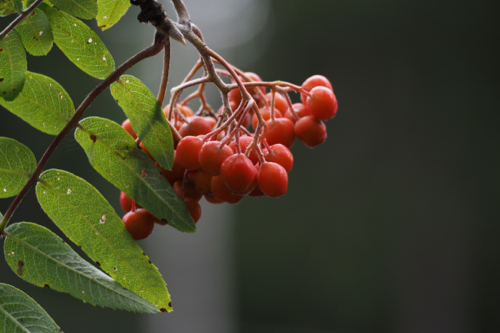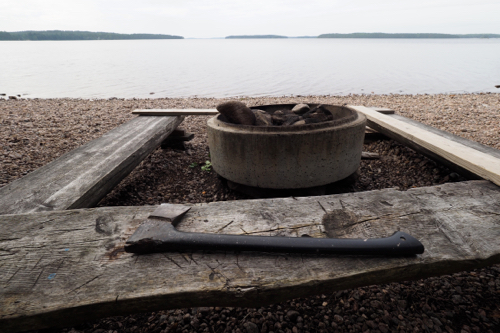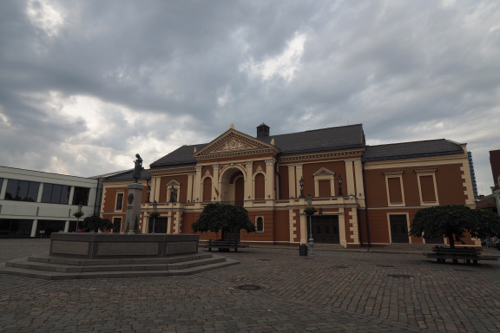
August 31, 2017. Kuldīga, Latvia to Klaipeda, Lithuania.
I put on shorts for the first time in weeks and it was a good feeling.
How long the better weather would last along the Baltic Sea, was questionable, but I wanted to make the most of what little summer we had left.
On the way to Klaipeda in Lithuania we stopped in Liepāja for a coffee and then went to the beach.
Another stretch of wind blown sand.
There were more people in the water, as the temperature had climbed into the mid thirties.
You can certainly see while people from this part of the world are attracted to the Adriatic.
Wind turbines are a sure sign of wind and Liepāja is regarded as the windiest region in Latvia. There is a plan to construct a wind farm of 19 generators in the area.
We had come to Klaipēda, which is the gateway to the Curonian Spit. However the town offers more than just a stepping off point, with a relaxed, stylish lifestyle and many good bars and restaurants.
Klaipēda is the third largest city in Lithuania and situated on the confluence of the Kurškju and smaller Danēs rivers.
The most impressive part of the town is the Theatre Square and the Klaipēda Theatre. An attractive Neo-Classical building from 1857.
Surrounding the square are many bars and restaurants and the square itself is home to the local handicrafts stalls.
The square has seen some history.
On March 23, 1939, Adolf Hitler made a speech from the balcony of the Klaipēda Theatre. This followed Lithuania accepting the Nazi German ultimatum to surrender the region.
We had dinner in one of the many restaurants on the square and afterwards visited Nesé, the Irish Pub that was opposite. During dinner there were roars of delight and groans of displeasure coming from the pub and we wondered what football game was on.
It turned out to be a basketball game between Lithuania and Georgia.
Unfortunately for the locals, Georgia won by two points, in the dying moments. (Georgia 79 defeated Lithuania 77)
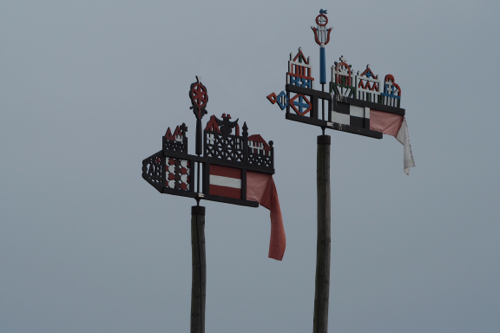
September 1, 2017. Klaipēda, Lithuania.
The Curonian Spit is a 98 kilometre long sand dune thats stretches from Klaipēda in the north to the Russian state of Kaliningrad in the south. It varies in width from 400 metres to nearly 4 kilometres.
It’s a UNESCO World Heritage Site shared by Lithuania and Russia and has an interesting history. Baltic mythology suggest that the Curonian Spit was created by a giantess, named Neringa, who was playing on the seashore. Apparently she scooped up sand and brought it there to shelter the local fishermen from violent storms on the Baltic sea.
There is a ferry that leaves Klaipēda every 20 minutes and crosses the Curonian Lagoon to Neringa on the Curonian Spit – on the other side of the spit is the Baltic Sea.
My faith in the weather improving was mistaken, as the morning was dark, overcast and cold. In defiance I stupidly put on my shorts.
Even that didn’t help.
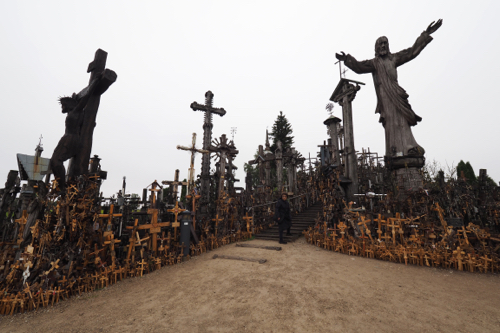
September 2, 2017. Klaipēda to Šiauliai, Lithuania.
The drive from Klaipēda to Šiauliai is about two hours, or 160 kilometres, depending on the roadworks.
The main reason for our one night stay in Šiauliai was to visit the Hill of Crosses. This is a pilgrimage site, about 12 kilometres out of the town.
It is believed that the first crosses were placed on the former Jurgaičiai or Domantai Hill Fort after the 1831 Uprising. (Also known as the Polish-Russian War of 1830-31)
All sorts of religious icons, large and small, have been placed on the hill by Catholic pilgrims.
Over the years they have come and gone, as political entities flexed their muscles.
In the late 1800’s there were an estimated 9,000 items on the hill and in 1922, just 50.
In 1961 the Soviets destroyed 5,000 and in 1975 a further 1,200 more.
During the years of Soviet occupation, the Lithuanians used the hill to demonstrate their allegiances to their original culture and identity.
By 1990 there were 55,000 items placed there and it is estimated that there are well over 100,000 there today.
There was certainly a lot and I wasn’t about to start counting.
It’s also a popular place to visit for locals, especially wedding parties. Two groups turned up while we were there.
The city of Šiauliai was said to have been founded in 1236. It was named Saule, after the Battle of Saule, or Sun, fought in the same year.
We found no sun in Šiauliai.
In Šiauliai we were staying at the Hotel Turnê. This was another Soviet era pub with the mandatory USSR Green walls.
After trolling through TripAdvisor I found what looked like good place to eat. Black Bar described itself as a gastropub and they had 12 draught beers on the menu.
Things were looking great.
When I went to order one of the beers, I was told that they only had two available.
The food was good.
We had just finished our meal and the reality TV, that was in the background and mute, was turned off and the Eurobasket was turned on. It was live, loud and suddenly the pub was full.
We didn’t stay to watch the game but later discovered that the locals had a good win against Israel. (Lithuania 88 defeated Israel 73)
They love their basketball in Lithuania.

September 3, 2017. Šiauliai to Kaunas, Lithuania.
Kaunas was first mentioned in history in 1361.
Over time It has been invaded or occupied by the Russians, Swedes, French and Germans.
It is Lithuania’s second largest city with a population of over 300,000. Up until the Second World War there was a large Jewish population living in Kaunas. Under the Nazi occupation many were exterminated.
We arrived in Kaunas mid afternoon and our accommodation, Hotel Hof, was just meters from the main walking street.
It was a Sunday afternoon yet the place was buzzing, especially compared to Šiauliai, where we had been the night before.
We found Green Cafe, a free trade, eco-sustainable coffee house. It was stylish and the coffee was good.
In the afternoon we visited Vytautas the Great War Museum.
The weather was still overcast with intermittent drizzle. What better place to go than a museum on a foul day.
The museum was established in 1921 and in its current location since 1930.
It was named after Vytautas the Great, a ruler of the Grand Duchy of Lithuania. Born in 1350 he is regarded by modern day Lithuanians as a national hero. Posthumously he was an important figure in the 19th century national rebirth.
This museum is part of a complex containing, the War Museum, which is by far the largest and the M. K. Čiurlionis National Art Museum, the Ethnography Museum and periodic exhibitions.
They were designed by the eminent architects of the day, Vladimiras Dubeneckis, Karolis Reisonas, and Kazimieras Kriščiukaitis.
The theme of the museum is war, conflict and weaponry.
Something the Lithuanians know a lot about.
It traces the history of Lithuania, from the Stone, Bronze and Middle Ages to the current day.
The dioramas, in the early part of the exhibition, were a great way to see how fortifications developed over the millennia.
Another fascinating display was the Exhibition of the History of Weapons. It displayed swords, rifles and handguns from the 16th to the 20th Century.
The Main Street in Kaunas was alive and the blare of the TV sets in the bars and pubs was deafening.
Lithuanian sides were competing in both basketball and football, so there was no escaping the excitement.
We did manage to find a local restaurant, off the main drag that was quiet.
They didn’t have a TV.
In fact it was so quiet, that apart from the two of us, there were only four others in the place, at various times during the night.
The food was great but, as to be expected, there wasn’t much ambiance.
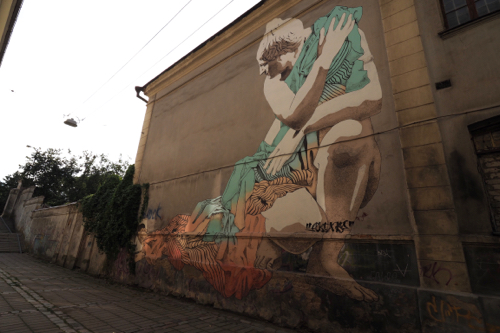
September 4, 2017. Kaunas, Lithuania.
Kaunas is the second largest city in Lithuania and is on the confluence of the Neris and Nemunas rivers. It is a cultural, economic and academic hub. It has been named ‘Little Paris’ due to its rich heritage and architecture.
It was a Monday and everything was shut, especially the museums, so we decided to walk.
Our first stop was the Bank of Lithuania which was built in in 1928, in a Neoclassical style, as a result of a competition held in 1924. A French company initially won the tender but the plans were deemed to be far too complex and expensive. The responsibility then passed into local hands and M. Songaila, the only Lithuanian professor of architecture at the time, was appointed.
He also happened to be the chairman of the jury judging the competition.
One of the main features of Kaunas is Laisvės Alėja. It is supposedly the longest pedestrian avenue in Eastern Europe, measuring 1.6 kilometres.
Walking the entire length, there and back, gave us some exercise and an excellent opportunity to see the city.
At the start of 2017 Kaunas was chosen as one of the European Capitals of Culture and it’s easy to see why.
Stunning street murals are everywhere.
One that particularly attracted my attention was the giant wall painting entitled Wise Old Man. This 440 square metre artwork, on the side of an abandoned factory, was created by Gyva Grafika in 2013.
We then crossed over the Nemunas River to ride the Aleksotas Funicular Railway. Opened in 1935, it’s not the oldest funicular in Kaunas, that honour goes to the Žaliakalnis Funicular, built in 1931.
The weather turned balmy in the afternoon and we actually took our coats off.
That didn’t last as it was raining again that evening.
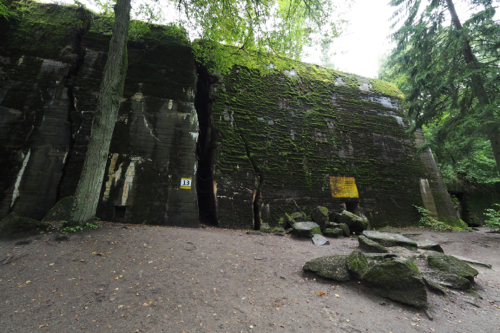
September 5, 2017. Kaunas, Lithuania to Reszel, Poland, including Wolf’s Lair.
It was a long day of driving and sightseeing.
It’s approximately 280 kilometres from Kaunas, in Lithuania to Reszel, in Poland. The famous hideout for Hitler and his henchmen, Wolf’s Lair, was on the way.
We were also loosing an hour of daylight, as there was a time change moving from Lithuania to Poland.
Wolf’s Lair was Adolf Hitler’s first Eastern Front military headquarters. It was a high security site hidden deep in the Masurian woods. Hitler spent more than 800 days at Wolf’s Lair and it was there that the most famous assassination attempt was made on his life on July 20, 1944.
The name ‘Wolf’ was one that Hitler gave to himself in the early 1930s.
The forrest complex is 6.5 square kilometres in area and at it height of use housed about 2,000 people.
Hitler departed from the complex on November 20, 1944 when the Red Army’s Baltic Offensive reached Angerburg, (now Węgorzewo) which was only 15 kilometres away.
Wolf’s lair was demolished by the Soviets on January 24 and 25, 1945. It is estimated that it took 8,000 kilograms of TNT to partially destroy the buildings.
What remains there now is a mass of reinforced steel and concrete that’s slowly disappearing back into the forest.
We arrived in Reszel late in the afternoon and had a quick walk around the castle. As we were actually staying in the Zamku Reszel, the hotel within the castle, we decided to do a more comprehensive tour the next day before we left for Gdansk.

September 6, 2017. Reszel to Gdánsk, Poland.
The castle in Reszel, apart from being our accommodation, was the town’s main tourist attraction. Reszel is dominated by both the castle and the Peter and Paul Church, which is practically next door.
The castle was built by the Teutonic Order between 1350 and 1401, while the church was built in much the same time from 1360 to 1402.
Both are in red brick and built in the Gothic style.
Apart from climbing the castle tower, which gives you an excellent vista of the town, it’s the Reszel Tower Museum that’s within, that holds the most interest.
The main theme of the museum is Medieval torture.
There are 30 plus methods of inflicting pain in the torture tower and a further 25 methods were on display in the dungeon.
The Virgin of Nuremberg, or Iron Maiden was a standout.
Used in the 16th century to torture and extract confessions, this 2.2 meters high casket could accommodate a man standing. The victim was tied inside the Maiden and when the doors were shut spikes would penetrate the flesh. The spikes were strategically places so as to not damage the vital organs.
They didn’t want the victim to die immediately – just suffer.
Once the doors were completely closed their screams couldn’t be heard from outside and concurrently the victim couldn’t see any light or hear anything from the inside.
Talking of torture.
Summer and autumn in Europe is wasp season. Whenever you eat outside these flying pests, with a nasty sting, want to sample your food and drink. Especially if what you are consuming is sweet.
They hover around the table and the more you try to wave them away the angrier they get.
We have found that the best strategy is to just ignore them and, like most pests, they give up and leave.
After our castle experience in the morning we started the drive to the Baltic coast and Gdansk. It was a good trip until we got to within 30 kilometres and then we struck roadworks – again.
When we arrived in Gdansk it was raining – again.
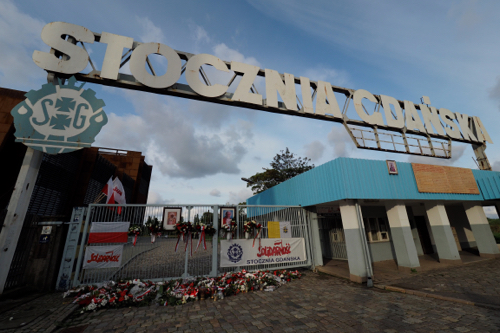
September 7, 2017. Gdánsk, Poland.
Gdansk was first established as a Polish stronghold in the 980s and over the centuries has been ruled by the Prussians, Germans, Russians and Poles.
We were in Gdansk to try and get an understanding of this famous Polish port city. I first remember hearing about Gdansk in the early 80s. It was the home of Lech Wałęnsa and the Solidarity Movement – a movement credited by many, with the fall of the Soviet Union.
Solidarity was the first independent labor movement in the Soviet-bloc and spawned an anti-communist social movement that, at its peak, claimed 9.4 million members.
What set it apart was the fact that it was non violent.
The morning was spent dodging the rain and exploring this beautiful old town.
We were staying in another apartment but unfortunately couldn’t find a good supermarket. This meant that we couldn’t self-cater for breakfast as we normally do.
We had to eat out yet again.
In the afternoon we joined a free 2.5 hour Solidarity walking tour around Gdansk.
Kasia was our guide and she made it very clear, right from the start, that she expected a tip.
So it was free in name only, which wasn’t an issue as it was worth every Złoty of the tip.
The tour was designed to put the Solidarity movement in context. It traced the the Polish freedom movements growth from 1945, culminating in the Revolution of 1989.
The tour covered a lot more than Lech Wałęsa.
We were taken around the city and shown how it had been restored after the Second World War. The restoration of Polish cities like Warsaw and Gdansk was a miracle, especially when you see what was left of the them after 1945.
Many parts of the city were rebuilt during the 1950s and 1960s. Any trace of German influence and tradition was suppressed and only Flemish/Dutch, Italian and French influences were revived.
Fittingly the tour finished at the European Solidarity Centre, near the Gdansk Shipyards. Opened in 2014 the museum and library is dedicated to the Polish Solidarity Movement and other opposition movements in Communist Eastern Europe.
The design is intended to suggest the hulls of a ship built at the Gdansk Shipyard.
Both the interior and exterior are made of steel which have oxidised to produce a rust effect.
There is a rooftop terrace with views of the Gdansk shipyards on one side and the a city-scape on the other.
The building is an impressive example of contemporary architecture.
Supposedly Lech Wałęsa has an office there.
We didn’t see him.
Kasia did share her views of the current state of Polish politics. She did take care to mention that she really shouldn’t discuss political issues. But…
One of the things that disturbed Kaisa most was the demonising of Lech Wałęsa by the current right-wing populist government in Poland.
Many fear that Poland is on the road from a liberal democracy to authoritarianism. There is a push within Polish politics to re write the history books regarding the Second World War and the rise of the Solidarity Movement. The Polish government is also turning its back on many of the liberal values and democratic principles that are a core part of the European Union, to which it belongs.
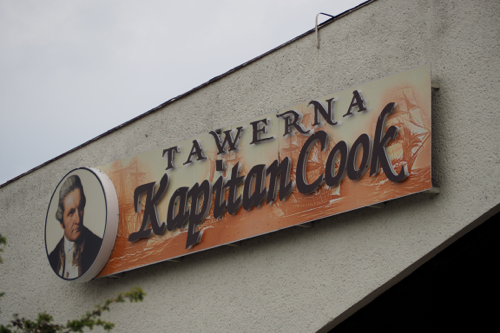
September 8, 2017. Gdánsk, Poland.
We took a day trip by train to Gdynia, Polands largest port on the Baltic Sea.
We actually got off by mistake at Sopot, which is a seaside and spa town. We then hopped on the next train to Gdynia.
The trains were running every fifteen minutes so we didn’t waste much time.
I was very impressed with the tourist facilities provided by the city. The Observatory of Change in Gdynia was a viewing platform. This was free to visit and gave the tourist a great view of the city and port area.
There was also an InfoBox at the top of the tower that allowed people to discover more of the city. You could find out where the public parking and city bikes were located and see the trolley bus routes.
We then took the two minute ride on the Kamienna Góra Funicular to the top of the Kamienna Góra Hill, which is near the centre of the town. Again it was free and we got another good view. Unfortunately the weather was rather grey.
Gdynia is one of the youngest cities in Poland, only receiving its rights in 1926. Before that it was only a fishing village.
Because of its young age the architectural style of the day was chosen for many of the buildings. This has led to it becoming the Modernist capital of Poland.
Even now, many of the contemporary buildings have adopted elements of Modernism.
Modernist is the most important new architectural style of the 20th century. It turned its back on ornament and embraced minimalism.
Steel, glass and reinforced concrete are the most populate building materials in Modernist architecture.
There are a number of leisure craft on Passenger Ship Alley, some still sail, but most don’t.
There was one ship that impressed me the Orb Błyskawica. This destroyer was built in England between 1935 and 1937 and certainly saw some action during the Second World War.
It was involved in the evacuation of Dunkirk and the Normandy landing, as well as operating in the North Atlantic, the Pacific and Bay of Biscay.
On returning to Gdansk we wandered down to the Motlawa River again and took a few snaps of The Crane.
Built in 1444 this Medieval ship’s loading crane used hemp rope and a system of blocks and two wooden turnstiles. The crane was powered by men walking inside the turnstiles to load cargo and erect masts onto the ships moored by the river’s edge.
On the last night we discovered a proper supermarket, just around the corner from our apartment. The one we found on our first night was very average.
And much to my horror we also discovered a Craft Beer Pub, Labeerynt, also nearby.
We had been looking in the wrong direction.
At least we found it before we left. Imagine discovering it as we drove away.

September 9, 2017. Gdánsk to Poznań, via Toruń, Poland.
It was 299 kilometres to Poznań. Not a long drive but considering our luck with roadworks, we expected the worse.
We stopped for lunch at Toruń but once we got there, finding the Old Town wasn’t easy.
Both our satellite navigation systems (one in the car and the other in our travel phone) sent us to an obscure part of the city, certainly not the centre. We have discovered that the Tourist Information Office is usually in the centre of most towns and cities and near the main town square, if there is one.
This is definitely an area that Sat Navs can improve on. I must talk to Hayden about that.
This was definitely a town on the tourist map as the streets were bulging with tour groups.
Toruń is a UNESCO World Heritage City, but more than that it is the City of Copernicus.
Copernicus monuments, street names, houses and souvenirs are everywhere.
Born in Toruń in 1473, Copernicus was a Renaissance Man, in every sense. He was a mathematician, astronomer, physician, governor, diplomat and economist.
His greatest claim to fame was in developing the Copernican Revolution, that put the sun at the centre of the universe (Solar System) not the earth.
The foundation charter for Toruń was signed in 1233 by Herman von Salza, the Grand Master of the Teutonic Order. It was managed by the Knights until 1454 when it became incorporated into the Polish Republic.
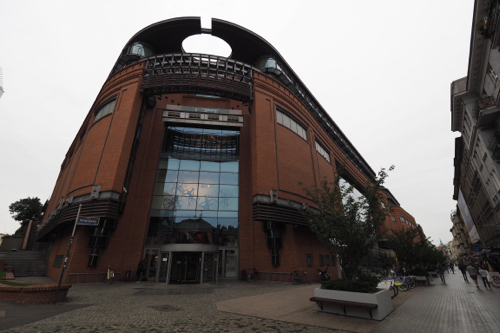
September 10, 2017. Poznań, Poland.
Poznań is one of the ancient cities of Poland.
It’s earliest remains can be traced back to the Stone Age. It was first written about in history as early as 966 and became a city in 1253.
On our first night we just wandered into the Old Town to find some dinner. This wasn’t as easy as we had imagined.
Everyone was drinking and there seemed to be very few people eating.
The next morning we walked down the length of Stary Browar. This is a huge mall and arts complex, just opposite our hotel.
The architecture was strikingly industrial, with red brick and steel. Not surprising, as it was built on the site of the old Brewery Huggerów.
The award Winning design of Stary Browar, or Old Brewery, has preserved much of the architecture and many elements of the original brewery.
The first brewery was constructed on the site in 1844, by a brewer from Württemberg, Ambrosias Hugger.
The walk through the mall kept us out of the rain, at least until we reached the Póhwiejska, the walking street.
We spent the rest of the day wandering around Poznań.
Firstly to the Old Market Square, one of the most attractive in Europe. The main feature is the Renaissance Town Hall, designed by the Italian architect, Giovanni Baptista Quadro.
Like many Polish cities the buildings surrounding the square have been painstakingly reconstructed, after the destruction of World War Two. The building facades are painted in subtle shades of creams, greens and browns and many of them also have intricate decoration.
Then to the lavish Baroque masterpiece, the Parish Church of St Stanislas.
We took the King’s route, which is a tourist walking path, to the see the Cathedral Basilica of St Peter and Paul on Cathedral Island. Originally built in the 10th century but rebuilt after WW2, when it was badly damaged.
The cellar holds the relics of the first rulers of Poland from the 10th century.
Apart from old architecture there are some modern buildings in Poznań. One of the most striking is the Poznań Gate Ichot. This is a history museum that is linked to the Old City by a suspended footbridge over the Cybina River.
Back in the Old Town we discovered the Nikon Polish Press Photography competition, which was at the rear of the Parish Church of St Stanislaus.
That night we went back into the Old Town and again found very few people eating.
Poznań is a draw card for tourists, especially from Germany and Britain.
It could be the lower prices and excellent shopping or the fact that there are so many places to get a drink.
